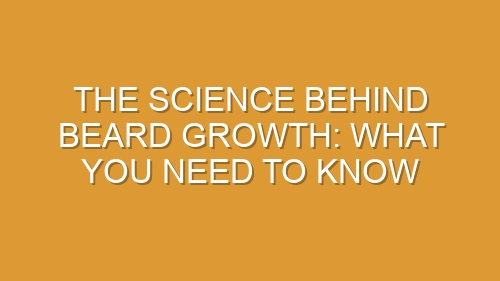-
Table of Contents
The Role of Hormones in Beard Growth
Beards have become increasingly popular in recent years, with more and more men embracing their facial hair. But have you ever wondered why some men can grow a thick, full beard while others struggle to grow even a few patches? The answer lies in the science behind beard growth, specifically the role of hormones.
Hormones play a crucial role in the development of facial hair. Testosterone, the primary male sex hormone, is responsible for stimulating the growth of facial hair. During puberty, testosterone levels increase, triggering the development of secondary sexual characteristics, including the growth of facial hair.
But testosterone alone is not enough to determine beard growth. Another hormone called dihydrotestosterone (DHT) also plays a significant role. DHT is derived from testosterone and is responsible for promoting the growth of facial hair follicles. It binds to receptors in the hair follicles, stimulating their growth and development.
The amount of testosterone and DHT in your body is largely determined by genetics. Some men naturally have higher levels of these hormones, which can lead to faster and thicker beard growth. On the other hand, men with lower levels of testosterone and DHT may struggle to grow a full beard.
In addition to genetics, other factors can influence hormone levels and, consequently, beard growth. Age, for example, plays a role. Testosterone levels tend to peak during adolescence and early adulthood, which is why many young men experience rapid beard growth during this time. As men age, however, testosterone levels gradually decline, leading to slower beard growth and even patchiness.
Lifestyle choices can also impact hormone levels and beard growth. Poor diet, lack of exercise, and high stress levels can all contribute to hormonal imbalances that affect facial hair growth. Eating a balanced diet, exercising regularly, and managing stress can help maintain optimal hormone levels and promote healthy beard growth.
It’s important to note that beard growth is a gradual process that takes time. It’s not uncommon for it to take several months or even years for a beard to reach its full potential. Patience is key, as rushing the process can lead to disappointment and frustration.
If you’re struggling to grow a beard or are unhappy with the progress, there are a few things you can try. First, make sure you’re taking care of your skin. Keeping your face clean and moisturized can create a healthy environment for hair follicles to thrive. Additionally, consider using beard oils or balms to nourish the hair and promote growth.
If you’ve tried everything and still can’t grow a beard, don’t despair. There are other options available, such as beard transplants or using minoxidil, a medication that stimulates hair growth. Consulting with a dermatologist or a specialist in facial hair can help you explore these options and find the best solution for you.
In conclusion, the science behind beard growth is fascinating, and hormones play a crucial role in determining the thickness and speed of growth. While genetics largely determine hormone levels, lifestyle choices can also impact beard growth. Remember to be patient and take care of your skin, and if all else fails, there are alternative options to explore. Embrace your facial hair journey and enjoy the process of growing a beard that suits your unique style.
Understanding the Hair Growth Cycle and Beard Growth
Have you ever wondered why some men can grow a full, luscious beard while others struggle to grow even a few patches of facial hair? The answer lies in the science behind beard growth. Understanding the hair growth cycle is key to understanding why some men can effortlessly grow a beard, while others may struggle to achieve the same result.
The hair growth cycle consists of three main phases: anagen, catagen, and telogen. The anagen phase is the active growth phase, during which the hair follicles produce new hair cells. This phase typically lasts for several years and determines the length of your hair. The catagen phase is a transitional phase, where the hair follicles shrink and detach from the blood supply. This phase lasts for a few weeks. Finally, the telogen phase is the resting phase, during which the hair follicles remain dormant for a few months before the cycle starts again.
When it comes to beard growth, the length of the anagen phase is crucial. The longer this phase lasts, the more time your facial hair has to grow. This is why some men can grow a beard quickly, while others may take longer. Genetics play a significant role in determining the length of the anagen phase. If your family has a history of thick, full beards, chances are you have inherited the genes for a longer anagen phase, making it easier for you to grow a beard.
Hormones also play a vital role in beard growth. Testosterone, the primary male sex hormone, is responsible for stimulating facial hair growth. During puberty, testosterone levels increase, triggering the development of secondary sexual characteristics, including facial hair. However, testosterone alone is not enough to grow a beard. Another hormone called dihydrotestosterone (DHT) is responsible for promoting beard growth. DHT is derived from testosterone and binds to receptors in the hair follicles, stimulating their growth. This is why some men may have high levels of testosterone but still struggle to grow a beard if their bodies do not convert enough testosterone into DHT.
Age is another factor that affects beard growth. As men age, their testosterone levels naturally decline, which can lead to slower beard growth. Additionally, the hair follicles may become less responsive to hormones, resulting in thinner, sparser facial hair. This is why many men find that their beards become fuller and thicker as they get older.
While genetics, hormones, and age are the primary factors influencing beard growth, there are a few things you can do to promote healthy facial hair growth. Eating a balanced diet rich in vitamins and minerals, particularly biotin, zinc, and vitamin D, can support hair growth. Regular exercise and managing stress levels can also contribute to healthy beard growth. Additionally, using beard oils and balms can help moisturize the skin and promote healthy hair follicles.
In conclusion, understanding the hair growth cycle and the factors that influence beard growth can help you better comprehend why some men can effortlessly grow a beard while others struggle. Genetics, hormones, and age all play a significant role in determining the length and thickness of your facial hair. While you cannot change your genetics or age, you can take steps to promote healthy beard growth through a balanced diet, exercise, and proper grooming. So, embrace your unique beard growth journey and enjoy the process of cultivating your own signature facial hair style.
Factors Affecting Beard Growth: Genetics, Age, and Lifestyle
Have you ever wondered why some men can grow a full, luscious beard in a matter of weeks, while others struggle to grow even a few patches of facial hair? The answer lies in a combination of factors that affect beard growth, including genetics, age, and lifestyle. Understanding these factors can help you better understand your own beard growth journey.
Genetics play a significant role in determining the thickness and growth pattern of your beard. Just like the color of your eyes or the shape of your nose, the ability to grow a beard is largely determined by your genes. If your father or grandfather had a thick, full beard, chances are you will too. On the other hand, if your family has a history of patchy or sparse facial hair, you may have to work a little harder to achieve the beard of your dreams.
Age is another factor that affects beard growth. During puberty, hormonal changes in the body trigger the growth of facial hair. This is why many teenage boys start to notice the first signs of a beard around the age of 14 or 15. As you get older, however, the rate of beard growth may slow down. This is because the production of testosterone, the hormone responsible for stimulating beard growth, decreases with age. So, if you’re in your 40s and still waiting for that full beard to come in, don’t lose hope – it may just take a little longer.
Your lifestyle can also impact the growth of your beard. Factors such as diet, exercise, and stress levels can all play a role in how quickly and how well your beard grows. A healthy diet rich in vitamins and minerals, particularly those that promote hair growth, can help nourish your facial hair follicles and encourage faster growth. Regular exercise improves blood circulation, which can also stimulate hair growth. On the other hand, high levels of stress can disrupt the natural hair growth cycle, leading to slower beard growth or even hair loss.
In addition to these factors, there are a few other things to keep in mind when it comes to beard growth. First, be patient. Growing a beard takes time, and it’s not uncommon for it to take several months before you start seeing significant growth. Second, resist the urge to trim or shape your beard too early. While it may be tempting to tidy up those stray hairs, trimming too soon can actually hinder growth. Finally, take care of your beard. Regular washing, conditioning, and moisturizing can help keep your facial hair healthy and promote growth.
In conclusion, the science behind beard growth is a fascinating topic. Genetics, age, and lifestyle all play a role in determining how quickly and how well your beard grows. While you may not have control over your genes or your age, you can certainly take steps to optimize your lifestyle and promote healthy beard growth. So, whether you’re a seasoned beard grower or just starting out on your beard journey, remember to be patient, take care of your beard, and embrace the unique growth pattern that is uniquely yours.





















